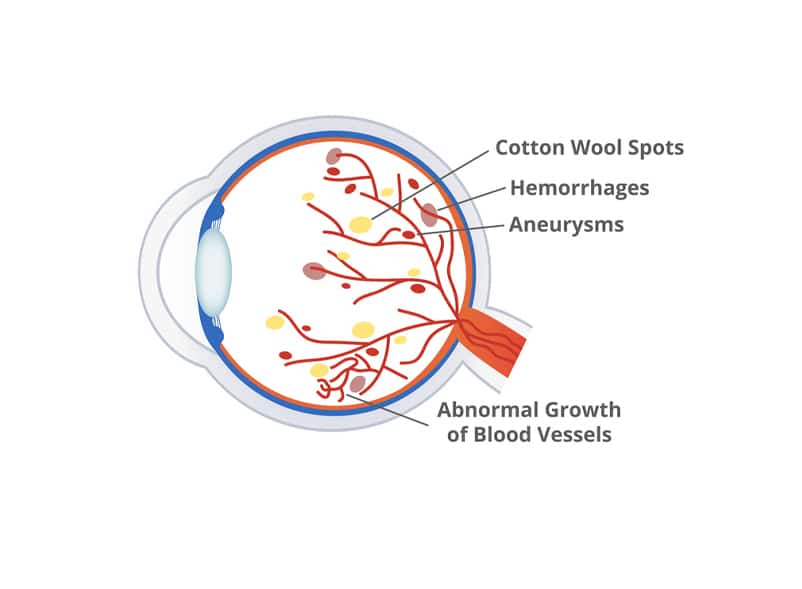Provo’s Eye Care Provider for Diabetic Retinopathy
Diabetic retinopathy is a complication of uncontrolled diabetes that causes damage to the blood vessels of the retina—the light-sensitive tissue that lines the back part of the eye, allowing you to see fine detail. It is the most common cause of irreversible blindness in working-age Americans. Diabetic retinopathy occurs in more than half of people who develop diabetes.
Those with diabetic retinopathy may not notice any symptoms. Therefore anyone with Type I or Type II diabetes needs to have regularly scheduled eye exams to monitor and treat this condition. Common symptoms and risk factors can be mistaken for minor irritations or unrelated concerns, but our eye care specialists can help.

What are the Risk Factors for Diabetic Retinopathy?
Various factors influence the risk of developing diabetic retinopathy. Elevated blood sugar levels, high blood pressure, and having diabetes for a long time are significant risk factors. Smokers are also at increased risk, as well as pregnant women with gestational diabetes.
High cholesterol levels and genetic factors can further elevate the likelihood of developing this eye condition. Individuals with diabetes should be aware of these concerns and work closely with healthcare providers to manage and reduce their risk of diabetic retinopathy.
Symptoms of Diabetic Retinopathy
What Can Be Done to Prevent Diabetic Retinopathy?
Patients with diabetes frequently ask, “Is there anything I can do to keep from getting diabetic retinopathy or to prevent or treat vision loss once it occurs?”
If you have diabetes, the National Eye Institute suggests that you keep your health on TRACK:
If you have diabetes, it is extremely important to maintain the eye examination schedule put in place by your optometrist or ophthalmologist. How often an examination is needed depends on the severity of your disease. Regular retina exams can reduce the risk of developing more severe complications from diabetes.

Provo’s Diabetic Retinopathy FAQs
There are many approved treatments for diabetic retinopathy, including intravitreal (in the eye) injections, laser treatments, and surgery. The best treatment is prevention by taking control of your diabetes and having regular eye examinations. Early detection is the key to maintaining good vision for the rest of your life.
Diabetic retinopathy often leads to permanent damage. There are treatments that can potentially restore some vision but none that can entirely reverse the condition. While these treatments may not fully restore vision, they can be effective in preventing further deterioration.
As diabetes is a chronic condition, ongoing retinal damage, and potential vision loss remain a present concern even after treatment. Regular eye exams are crucial post-treatment, as additional interventions may be necessary at some point.
Stage 1: Mild nonproliferative retinopathy is characterized by microaneurysms in the blood vessels of the retina.
Stage 2: The moderate stage, where blood vessel swelling may lead to blurry vision.
Stage 3: This is severe nonproliferative retinopathy, which involves the growth of new, fragile blood vessels causing significant vision issues.
Stage 4: The final stage, proliferative retinopathy, features the formation of scar tissue and potential retinal detachment, which can result in permanent blindness.
Request an Appointment
If you have diabetes (Type I or Type II), schedule an appointment at the Eye Clinic and Aesthetics of Provo right away. Our comprehensive eye exams can detect early changes in your retina from diabetes.
Together, we can create a plan to support your visual health by addressing key factors to reduce the risk of complications and preserve your eyesight. Call (801) 373-4550 or request an appointment using the link below.
